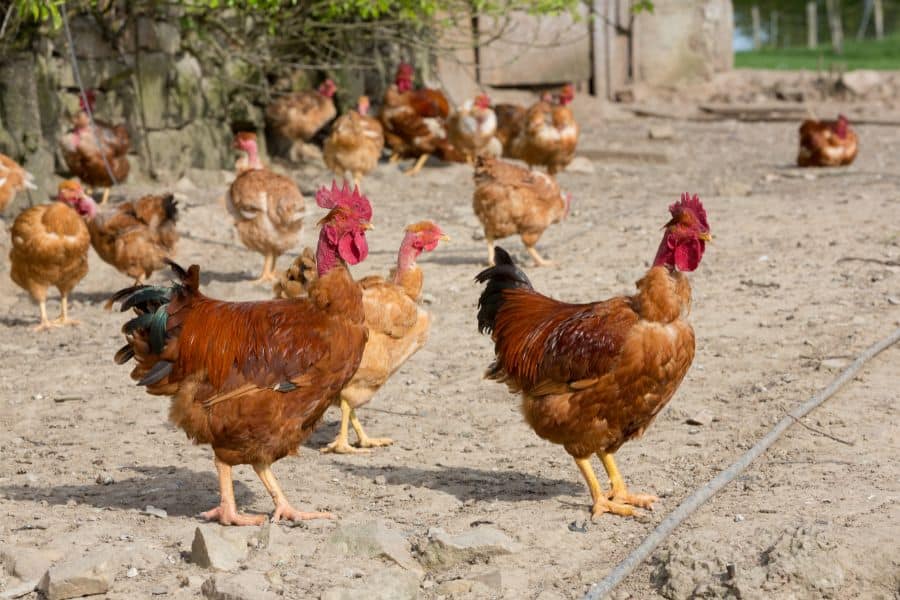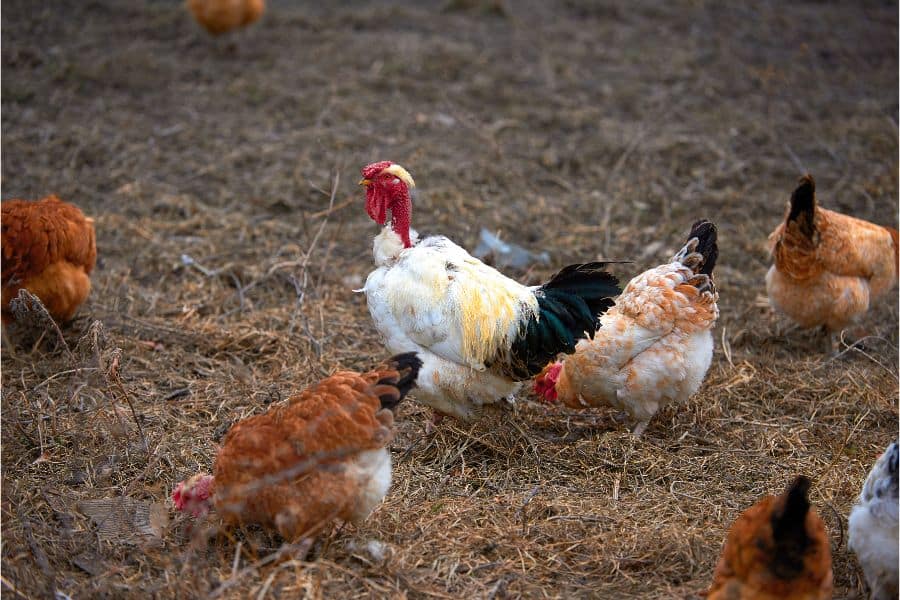The Naked Neck Chicken is a unique-looking bird with unclear origins. The unusual look of these chickens once led to the theory that they were the result of interspecies breeding.
Thanks to their size, the quality of their meat, and their laying ability, backyard farmers are becoming more interested in this breed today. The trait that gives them their unique look comes with more than one advantage for anyone looking to rear table birds.
Naked Neck Chickens can cope in environments that cause production rates and the health of other chicken breeds to suffer. Their adaptability has led to extensive studies in the hope that their genes and hardiness can be introduced to other chickens.
Read on to find out more about the fascinating Naked Neck Chickens and why many believe they have a key role to play in the future of chickens.
Naked Neck Chicken Quick Facts
| Names | Naked Neck, Transylvanian Naked Neck, Turken |
| Origin | Unknown (Asia or Europe) |
| Purpose | Meat and Eggs |
| Egg Production/Year | 120 – 200 |
| Climate | Very Heat Hardy, Cold Hardy |
| Plumage Color | Black, white, blue, cuckoo, red, and buff |
| Weight | Hens: 6.6 lbs.
Roosters: 8.6 lbs. |
| Personality | Calm and Docile |
| Unique Fact | The naked neck gene is being exploited to develop broilers that can thrive in hot climates. |
History of the Naked Neck Chicken
Origins
Naked Neck chickens are commonly thought to have originated in Asia. These chickens can be seen in centuries-old paintings from Japan. They were also bred for fighting in certain Asian countries.
Breeding of Naked Neck chickens in Transylvania (present-day Romania) is documented in the late 1800s. It was this connection that led to one of this chicken’s most common names, Transylvanian Naked Neck.
The development of this breed was later refined in Germany before it was taken to other parts of Europe and the Americas. The Naked Neck Chicken didn’t make it to Britain until the 1920s.
The Name
There is no mystery as to why these bare-neck chickens were called Naked Necks. Their necks are free from any sort of feather covering.
However, these birds have also been called Turkens. This came from the amusing theory that they were the result of crossing chickens and domestic turkeys.
Appearance of Naked Neck Chickens
Plumage
The most distinct trait of Naked Neck chickens is their bald necks and vents. They also have approximately half the total feather covering of regular chicken breeds.
The lack of feathers in this bird is due to a gene that can be easily introduced to other breeds. However, such individuals may still end up with a noticeable tuft of feathers on their necks due to genetic factors.
When exposed to a lot of sunlight, Transylvanian Naked Necks’ heads and necks turn bright red.
These chickens have a bit of feather growth at the top of their heads, and the roosters have single combs (some have rose combs).
In the USA, the black, buff, white, and red variants of Naked Neck Chickens are officially recognized. In the UK, the blue and the cuckoo variants are also recognized in addition to the four.
Size
Male Naked Neck Chickens can weigh as much as 8.6 pounds. The hens weigh slightly less, reaching a maximum of 6.6 pounds.
There is a bantam variant of Naked Neck Chickens. These should ideally weigh between 850 and 965 grams at maturity, i.e., 30 – 35 oz.
The Potential of Naked Neck Chickens as a Dual-Purpose Breed
Transylvanian Naked Neck Chickens are yet to become hit show birds although there is some potential. However, they have excelled as utility birds for farmers looking for dual-purpose breeds for their backyards.
Egg Production
Different farmers have different experiences with the egg-laying potential of Naked Neck Chickens. Some have had chickens that lay as little as 120 eggs per year, while others had chickens that produced as many as 200 eggs in the same period.
The eggs laid by Naked Neck chickens are light brown in color. These chickens are also fantastic layers during the cold winter months.
Meat Production
Naked Neck chickens have become common in both Europe and South America. One reason for this is the fact that they excel as meat birds.
These chickens feather quickly, and their bodies also develop fast. They could become important for meat production in countries such as Mexico where they cope better with the hot climate.
The lower amount of feathering on their bodies means they can be plucked faster than regular chickens. This makes it easier to process the birds after slaughter.
The birds yield a significant amount of meat with roosters weighing as much as 8.6 pounds or 3.9 kg. There are studies that have also shown a correlation between the Naked Neck gene and large breast sizes in chickens.
Raising Naked Neck Chickens
Housing and Environment
Naked Neck chickens have gained a reputation as some of the hardiest birds in the backyard. Their lack of feathering makes them an excellent choice for hot areas because it keeps them from getting too hot.
Surprisingly, this same lack of feathering hasn’t turned out to be a big issue during winter. Farmers living in places with cold winters have reported that although there is some risk of frostbit combs, their Naked Necks seem to do well during cold winters.
If you’re planning on getting a few Naked Necks for your backyard farm, a few things you should know are:
- Naked Neck chickens love to forage. It will be ideal if they can be raised under free-range conditions with plenty of open space.
- Naked Neck chickens can handle confinement well in case you don’t have a lot of space to work with.
- Despite their hardiness, it’s still a good idea to house your Naked Neck chickens in a comfortable, protected coop, especially from extreme cold.
- The combs of Naked Neck chickens may still be prone to frostbite.
- Naked Neck Chickens are poor fliers. This means you won’t need a very tall fence to keep them contained.
Feed and Nutrition
Feed is one of the most expensive aspects of rearing chickens which is why a competent forager like the Naked Neck Chicken is so appealing. However, that is only part of the story.
Even when raised in confinement, Naked Neck Chickens consume less feed compared to chickens with regular feathering.
They also have a better feed conversion ratio. This means that a Naked Neck Chicken consumes less food to produce the same amount of meat as a normal-feathered chicken.
These bald-neck chickens don’t have any special dietary requirements either.
Temperament
Naked Neck chickens are good for beginner farmers because they are not known for being aggressive. They are calm and docile, the kind of chicken that’s easy to tame in the backyard.
Lifespan
If you’re keeping a Naked Neck Chicken, you’re likely to have it for a long time. These birds are said to have lifespans of around 7 or 8 years.
These lifespans can be even longer under the right conditions. It certainly helps that these hardy birds are immune to most poultry diseases.
Breeding and Brooding in Naked Neck Chickens
Broodiness
It’s not unusual for Naked Neck Chickens to go broody. They not only go broody but will sit on eggs until they hatch and make excellent mothers.
However, the unusual feathering of these birds creates one key challenge. They can’t keep as many eggs warm as a normal feathered chicken.
Confirm that any Naked Neck hen sufficiently covers her eggs. If any eggs are left exposed, take out a few until all the eggs are properly covered.
Breeding
Naked Neck Chickens are a true breed. This means that the offspring of these chickens will all be Naked Necks and will carry the Naked Neck gene along with other characteristics of this breed.
Because the gene that causes the lack of neck feathering is dominant, there are hybrids with no neck feathers that are not true Naked Necks.
The Naked Neck Gene
Effect of Heat on Chickens
The exceptional heat hardiness of the Naked Neck chicken has made the breed the subject of many studies. Heat stress causes a lot of problems in chickens including:
- Reduced body growth
- Reduced production of eggs
- Death
Even the juiciness of broilers can be reduced by heat stress because it lowers the meat’s water-holding capacity. The challenge caused by heat is significant to the poultry industry because there has been an increase in poultry meat production in regions with hot climates.
For backyard farmers, heat can also be a problem when keeping chickens due to issues like heat waves even in parts of the world that are usually cool.
Naked Neck Chickens in the Heat
Several studies have shown that Naked Neck chickens fare far better than normal-feathered chickens in hot climates.
Thanks to this improved resistance to heat stress, Naked Neck chickens can gain more weight and have a significantly better feed conversion ratio compared to chickens with normal feathering.
The Naked Neck gene can have a positive impact on the:
- Rate of growth
- Quality of the meat
- Egg production rate
- Time to reach sexual maturity
- Fertility rate under heat stress
- General health of the chicken
There are differences depending on whether the chicken has one or two copies of the gene that causes the Naked Neck trait. However, there is plenty of evidence that when temperatures are high, Naked Neck chickens are what you want to have in your backyard.
The Future of the Naked Neck Gene
Due to climate change, heat stress will become a major issue for backyard chicken farmers. The ability of chickens with naked necks to adapt to rising temperatures means that this gene can be useful in mitigating the effect of heat on the production levels of your chickens.
Naked Neck Chickens’ hardiness and disease resistance may also make them the ideal birds for industrial meat production systems.
Introducing the naked neck gene to other lines of chickens is being considered. It may offer a more cost-effective way of dealing with the negative effects of higher ambient temperatures.
Read More: Why Is My Chicken Losing Feathers?
The Bird to Beat the Heat
Naked Neck Chickens have been around for centuries, but their lack of neck feathers gives them a unique advantage in modern times.
The geographical origin of Naked Neck chickens is unknown, but the characteristic lack of neck feathers is now known to be caused by a genetic mutation. This gene can be easily passed on to other chickens.
The appearance of Naked Neck Chickens may not be everyone’s favorite, but these are some of the best dual-purpose chickens to have in your backyard. The hens lay a fair number of eggs and they also provide a good amount of delicious meat.
Naked Neck Chickens are hardy and can cope with cold environments but, it’s in the heat that these chickens really tower above other breeds. If you’ve been looking for a heat-resistant dual-purpose chicken, the Naked Neck Chicken might be top of the class.


